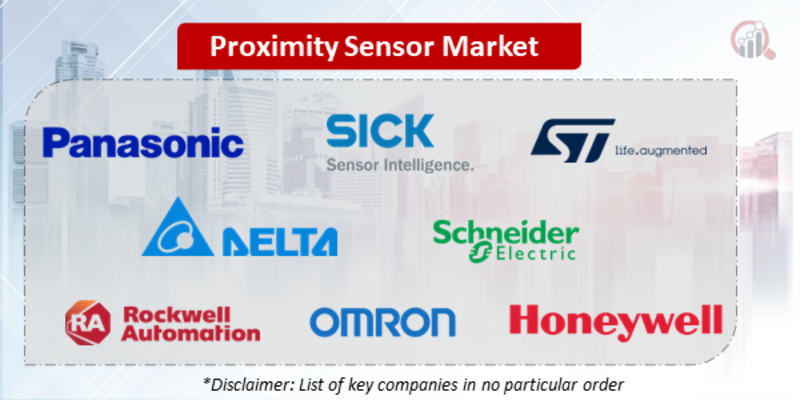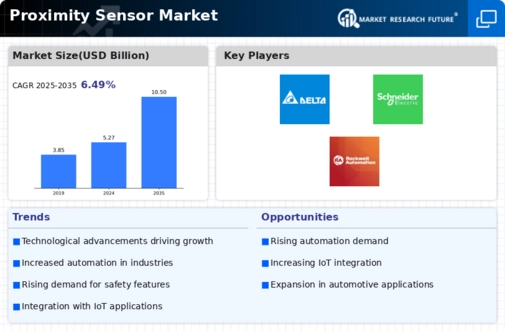Top Industry Leaders in the Proximity Sensor Market

Competitive Landscape of the Proximity Sensor Market:
The proximity sensor market pulsates with intense competition, fueled by a burgeoning demand for automation and advanced sensing technologies. This intricate landscape encompasses established industry giants, nimble startups, and regional players vying for market share across diverse application segments.
Key Players:
- Panasonic Corporation
- Riko Opto-electronics Technology Co. Ltd
- SICK AG
- STMicroelectronics NV
- Delta Electronics Inc
- Avago Technologies Inc
- Schneider Electric
- Rockwell Automation
- Omron Corporation
- Honeywell International Inc
Strategies Adopted by Key Players:
- Innovation & Differentiation: Leading players like Panasonic, Omron, and Honeywell prioritize continuous product development, emphasizing miniaturization, enhanced range, and integration with other sensor technologies.
- Strategic Partnerships & Acquisitions: Mergers and acquisitions are seen as potent tools for expanding geographical reach and acquiring complementary technologies. Recent examples include AMS's acquisition of Sensata Technologies and TE Connectivity's purchase of Interconnect Devices.
- Vertical Specialization: Players are tailoring their offerings to specific application segments, such as automotive, consumer electronics, and industrial automation, to cater to unique technical requirements and regulatory landscapes.
- Cost Competitiveness: Emerging players from Asia, particularly China, are challenging established players with cost-effective solutions, pushing for price optimization and supply chain efficiency.
Factors for Market Share Analysis:
- Product Portfolio Breadth & Depth: The sheer variety of sensor types (capacitive, ultrasonic, infrared) and their configurations offered by a company plays a crucial role.
- Geographical Presence & Distribution Network: Effective reach across key markets like North America, Europe, and Asia-Pacific significantly impacts market share potential.
- Brand Reputation & Customer Relationships: Established brands often command premium pricing and customer loyalty, influencing market share, particularly in the B2B space.
- Technological Expertise & Patent Landscape: Robust patent portfolios and a demonstrated commitment to R&D can create significant competitive advantages.
New & Emerging Companies:
- STMicroelectronics: Leveraging its strong semiconductor expertise, STMicroelectronics is developing highly integrated proximity sensors with low power consumption.
- Rohm Semiconductor: Focusing on miniaturization and multi-functionality, Rohm Semiconductor caters to the growing demand for space-constrained applications in consumer electronics.
- Sengit: This Israeli startup specializes in innovative Time-of-Flight (ToF) sensors, offering high accuracy and long-range proximity detection for emerging applications like gesture recognition.
Industry Developments
Panasonic Corporation:
- October 2023: Panasonic announced a new line of high-precision LiDAR (Light Detection and Ranging) sensors for autonomous vehicles and robots, leveraging their expertise in proximity sensing technology.
- July 2023: Partnered with a leading robotics company to develop proximity sensors for collaborative robots used in manufacturing and logistics.
- Focus: Expanding into ToF and LiDAR technology for advanced proximity sensing applications beyond traditional infrared sensors.
Riko Opto-electronics Technology Co. Ltd:
- September 2023: Launched a new series of miniature photoelectric proximity sensors with enhanced detection range and accuracy for industrial automation applications.
- June 2023: Received a major order from a Chinese smartphone manufacturer for their proximity sensors used in facial recognition unlocking features.
- Focus: Strengthening their position in the industrial and consumer electronics segments through innovative and cost-effective proximity sensor solutions.








